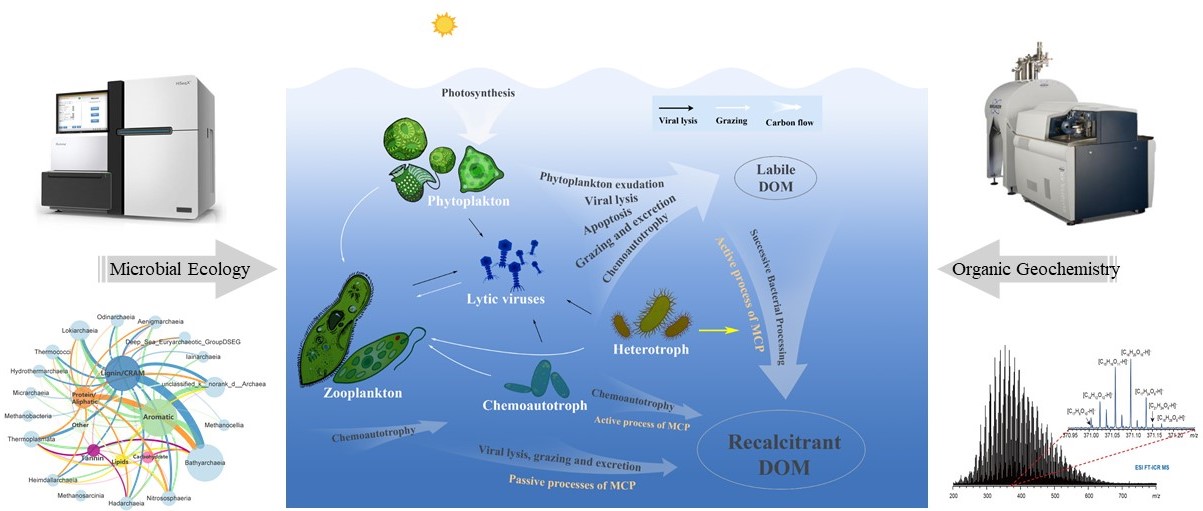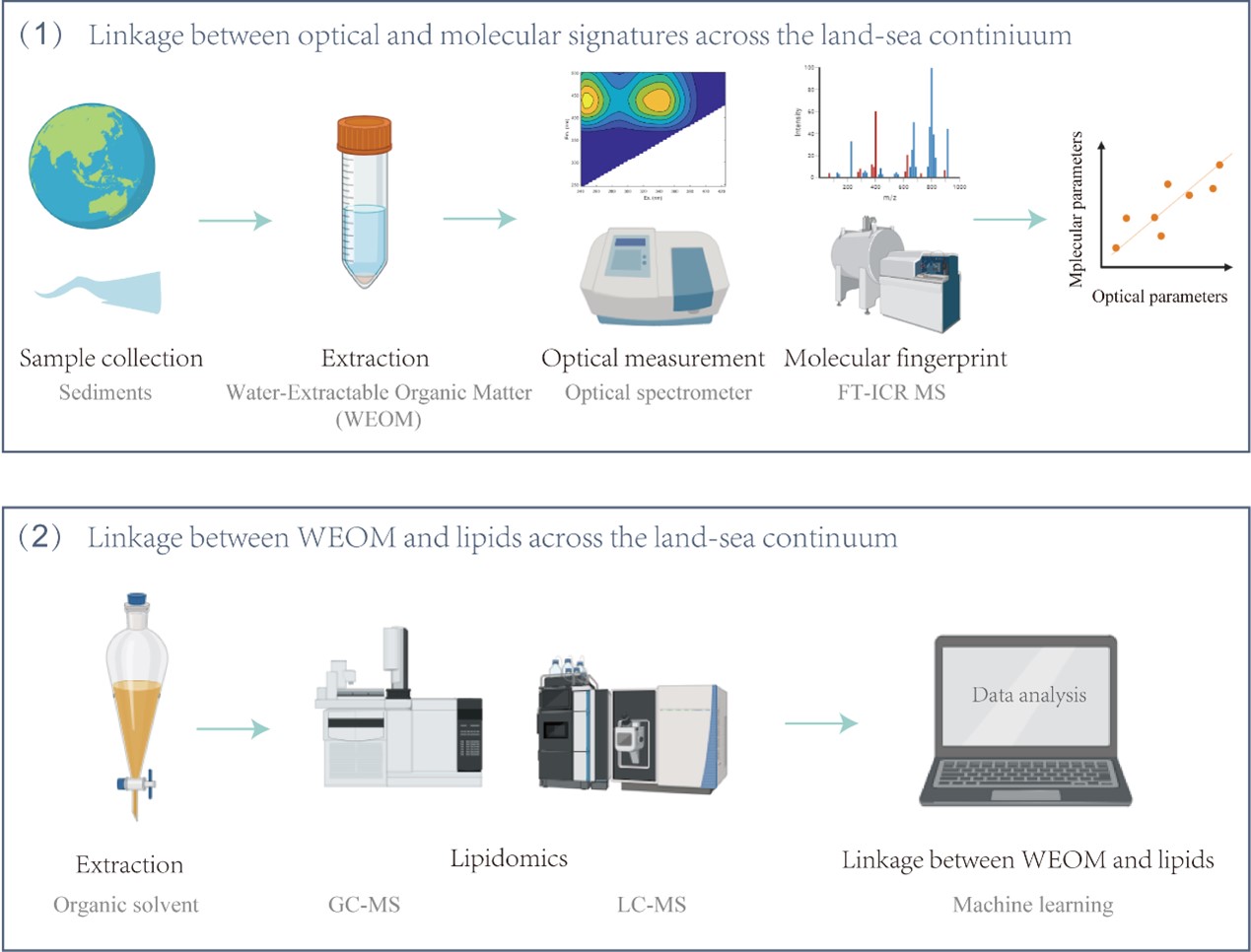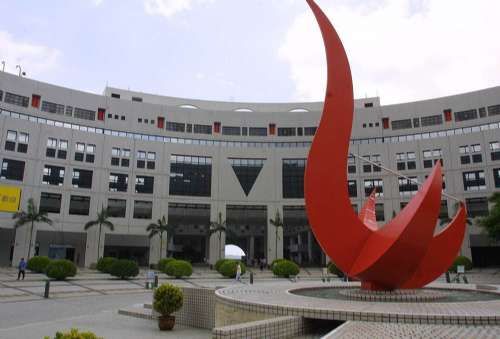Research
Dr. Ruanhong Cai: One of our recent research interests is to in depth understand the molecular composition and temporal/spatial distribution of natural dissolved organic matter (DOM) in various aquatic environments and sediments using state-of-the-art analytical chemistry tools, such as the ultrahigh resolution untargeted/liquid chromatography FT-ICR MS, the 3D EEM fluorescent spectrum, nuclear magnetic resonance, to name but a few. We also introduce methodologies in the microbial ecology and organic geochemistry to better understand how the complex microbial activities are involved in the transformation of DOM and the production of recalcitrant DOM, thereby facilitating better understanding of cycling and carbon sequestration of natural DOM in the aquatic environments and adjacent sediments.

Dr. Zhexuan Zhang: 1) Linkage between optical and molecular signatures Optical techniques (UV-visible absorbance and Excitation-Emission Matrix spectroscopy) are fast, sensitive, and inexpensive techniques that have been widely used to assess organic matter quality. They provide information about the aromaticity, molecular weight, and bioavailability of organic matter. However, interpreting optical parameters can be challenging due to the complex nature of organic compounds and a number of factors that can influence optical properties. On the other hand, molecular techniques like FT-ICR MS provide detailed molecular information by identifying thousands of molecular formulas that can help validate and enhance the interpretation of optical signatures. However, this level of characterization comes with a cost. It requires sophisticated equipment and expertise to operate, making it less accessible compared to optical methods. We want to establish a linkage between optical and molecular signatures. This linkage will enable efficient large-scale monitoring of organic carbon cycling processes across the land-sea continuum using optical techniques with robust interpretations.
2) Linkage between Water-Extractable Organic Matter (WEOM) and lipids Lipid biomarker analysis is a traditional organic geochemical method that provides valuable information about the sources and transformations of organic matter. It requires large sample amounts and is labor-intensive, making it less feasible for large-scale sampling campaigns. On the other hand, WEOM analysis offers a more efficient and less labor-intensive way to investigate organic matter dynamics but may lack the specificity provided by lipid biomarkers. Both lipid biomarkers and the WEOM-based approach have parameters that can trace terrestrial sources, algal influence, and anthropogenic impact. However, whether these indicators provide the same information is rarely investigated. By integrating these two approaches, we can potentially overcome some of the limitations associated with traditional biomarker analysis and gain a more comprehensive understanding of organic matter dynamics across the land-sea continuum.

Research funding
a) Funded as the leading PI (16 in total):
- RGC—Early Career Scheme (ECS), “Priming of terrestrially derived organic matter in estuarine and coastal environments” (26300822), (07/2022-06/2025).
- RGC—General Research Fund (GRF), “Investigation of phytoplankton-derived humic-like dissolved organic matter in estuaries and coastal oceans” (16306623), (01/2024-12/2026).
- National Science Foundation of China—Excellent Young Scientist (Hong Kong and Macau) Scheme, “Organic Geochemistry of Estuaries and Coasts” (42222061), (01/2023-12/2025).
- Open funding for the Center of Marine Carbon Sink and Biogeochemical Processes, National Natural Science Foundation of China— Basic Science Center Program, (07/2022-06/2025).
- Marine Ecology Enhancement Fund, “Assessing the ecological impacts of anthropogenic activities on the coastal wetlands in Hong Kong from the optical properties of sedimentary dissolved organic matter” (MEEF2023008), (07/2023-06/2024).
- Marine Conservation Enhancement Fund, “Exploring fluorescence spectroscopic characterisation of algal organic matter and its implication on early warning of harmful algal blooms in the fish culture zones of Hong Kong” (MCEF22005), (07/2023-06/2025).
- Funding from Center for Ocean Research Hong Kong - Macau, “Evaluating historical evolution of bottom water oxygen concentration in the Pearl River Estuary: insights from organic and inorganic geochemistry”, (03/2022-03/2023).
- SKLMP Seed Collaborative Research Fund, “Exploring microplastic-derived dissolved organic matter on both optical and molecular levels and its implication on the carbon cycling in the coastal water of Hong Kong”, (05/2023-4/2024).
- Funding from Hong Kong branch of Southern Marine Science and Engineering Guangdong Laboratory, “Changes in organic matter composition and behaviors in a eutrophic bay during red tide generation and elimination, implications for the carbon cycling”, (SMSEGL20SC01-22A), (01/2022-12/2022).
- Open funding of State Key Laboratory of Geomechanics and Geotechnical Engineering, “Occurrence and contribution of microplastics to the carbon storage of coastal wetlands in China”, (SKLGME022008), (07/2023-06/2025).
- Funding from Center for Ocean Research Hong Kong - Macau, “Assessing microplastic-derived dissolved organic matter chemistry and its effect on coastal carbon cycling of Hong Kong”, (07/2023-06/2024).
- National Science Foundation of China—General Program Scheme, “Sources, transformation processes, and impacts of organic matter in tidal river water on estuarine carbon cycling” (41973070), (01/2020-12/2023). ”
- National Science Foundation of China—General Program Scheme, “The organic matter source, transformation and deposition mechanism in the Three Gorges Reservoir”
- Central Funding from Ministry of Education of China, Coupling study on microbial community and degradation of sedimentary organic matter under environmental change gradient in the Yangtze Estuary Hangzhou Bay
- Qianjiang Talent program from Zhejiang Province, Biogeochemistry of estuaries and coasts
- Outreach funding from Tongji University, Biomarkers and paleoenvironment reconstruction in the South China Sea, China
b) Funded as the Co-PI (3 in total)
- RGC - Collaborative Research Fund, “A collision-cell equipped multi-collector inductively coupled plasma mass spectrometer (CC-MC-ICP-MS) for elucidating isotope fractionations in biological and chemical processes in the ocean” (C6006-22EF), (01/2023-12/2025).
- General Funding from Department of Science and Technology of Guangdong Province, “The impact of changing environment on the structure and function of the Pearl River estuarine food webs” (GDST22SC05), (06/2022-05/2024).
- Shanghai Annual Action Plan for Technological Innovation: Hong Kong, Macau, and Taiwan Science and Technology Cooperation Project, “Temporal and Spatial Variations in Organic Carbon Transformation and Burial in the Yangtze River Estuary-East China Sea”, (06/2023-05/2026).
c) Funded as the Co-I (1 in total)
- RGC – Areas of Excellence Scheme, “Study of the regional earth system for sustainable development under climate change in the Greater Bay Area” (AoE/P-601/23-N), (01/2024-12/2027).
